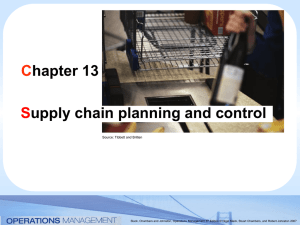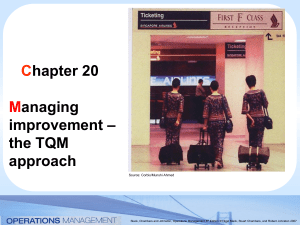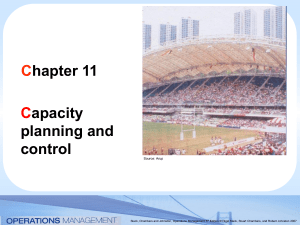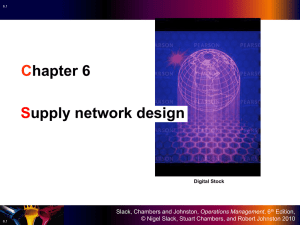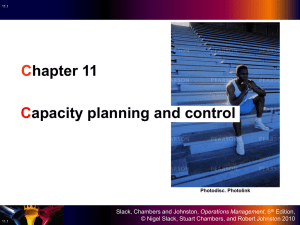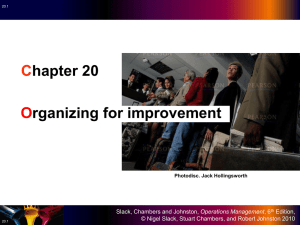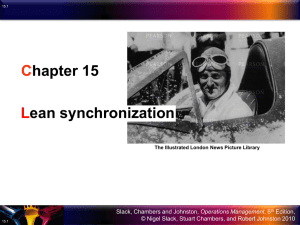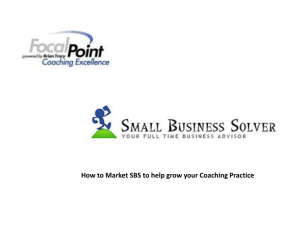PowerPoint Presentations 3
advertisement
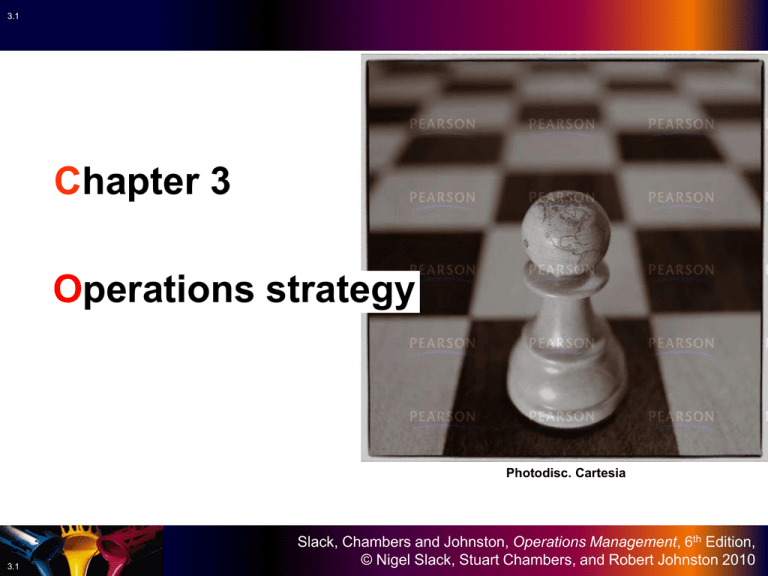
3.1 Chapter 3 Operations strategy Photodisc. Cartesia 3.1 Slack, Chambers and Johnston, Operations Management, 6th Edition, © Nigel Slack, Stuart Chambers, and Robert Johnston 2010 3.2 Slack et al.’s model of operations management Operation’s performance Operations strategy Design Operations management Operations strategy Improvement Planning and control 3.2 Slack, Chambers and Johnston, Operations Management, 6th Edition, © Nigel Slack, Stuart Chambers, and Robert Johnston 2010 3.3 Key operations questions In Chapter 3 – Operations strategy – Slack et al. identify the following key questions: • What is strategy and what is operations strategy? • What is the difference between a ‘top-down’ and a ‘bottom-up’ view of operations strategy? • What is the difference between a ‘market requirements’ and an ‘operations resources’ view of operations strategy? • How can an operations strategy be put together? 3.3 Slack, Chambers and Johnston, Operations Management, 6th Edition, © Nigel Slack, Stuart Chambers, and Robert Johnston 2010 3.4 Operations strategy at Flextronics and Ryanair For each of these companies: • What do they have to be good at to compete in their markets? • How do their operations help them to achieve this? 3.4 Slack, Chambers and Johnston, Operations Management, 6th Edition, © Nigel Slack, Stuart Chambers, and Robert Johnston 2010 3.5 Operations strategy at Flextronics Operations strategic decisions • Industrial parks, with – low cost but close locations – and co-located suppliers 3.5 Flextronics Market requirements • Low costs • Responsiveness • Flexibility Slack, Chambers and Johnston, Operations Management, 6th Edition, © Nigel Slack, Stuart Chambers, and Robert Johnston 2010 3.6 Operations strategy at Ryanair Operations strategic decisions • Stripped down service • One technology • Cheap airport locations • Fast turnround 3.6 Ryanair Market requirements • Low prices • Reliability • Basic service Slack, Chambers and Johnston, Operations Management, 6th Edition, © Nigel Slack, Stuart Chambers, and Robert Johnston 2010 3.7 What is strategy? • Setting broad objectives that direct an enterprise towards its overall goal. • Planning the path (in general rather than specific terms) that will achieve these goals. • Stressing long-term rather than short-term objectives. • Dealing with the total picture rather than stressing individual activities. • Being detached from, and above, the confusion and distractions of day-to-day activities. 3.7 Slack, Chambers and Johnston, Operations Management, 6th Edition, © Nigel Slack, Stuart Chambers, and Robert Johnston 2010 3.8 Strategic decisions Strategic decisions are those decisions which: are widespread in their effect on the organization to which the strategy refers, define the position of the organization relative to its environment and move the organization closer to its long-term goals. 3.8 Slack, Chambers and Johnston, Operations Management, 6th Edition, © Nigel Slack, Stuart Chambers, and Robert Johnston 2010 3.9 ‘Operations’ is not the same as ‘operational’ ‘Operations’ are the resources that create products and services. ‘Operational’ is the opposite of strategic, meaning day-today and detailed. So, one can examine both the operational and the strategic aspects of operations. 3.9 Slack, Chambers and Johnston, Operations Management, 6th Edition, © Nigel Slack, Stuart Chambers, and Robert Johnston 2010 3.10 How is operations strategy different to operations management? Operations management 1–12 months 3.10 Long-term for example, capacity decisions Demand The time scale is longer Demand Short-term for example, capacity decisions Operations strategy 1–10 years Slack, Chambers and Johnston, Operations Management, 6th Edition, © Nigel Slack, Stuart Chambers, and Robert Johnston 2010 3.11 How is operations strategy different to operations management? (Continued) Operations management Micro-level of the process Operations strategy Macro-level of the total operation The level of analysis is higher 3.11 Slack, Chambers and Johnston, Operations Management, 6th Edition, © Nigel Slack, Stuart Chambers, and Robert Johnston 2010 3.12 How is operations strategy different to operations management? (Continued) Operations management Detailed For example: The level of aggregation is higher 3.12 ‘Can we give tax services to the small business market in Antwerp?’ Operations strategy Aggregated For example: ‘What is our overall business advice capability compared with other capabilities?’ Slack, Chambers and Johnston, Operations Management, 6th Edition, © Nigel Slack, Stuart Chambers, and Robert Johnston 2010 3.13 How is operations strategy different to operations management? (Continued) Operations management Concrete The level of abstraction is higher 3.13 For example: ‘How do we improve out purchasing procedures?’ Operations strategy Philosophical For example: ‘Should we develop strategic alliances with suppliers?’ Slack, Chambers and Johnston, Operations Management, 6th Edition, © Nigel Slack, Stuart Chambers, and Robert Johnston 2010 3.14 3.14 What is the role of the operations function? Operations as implementer of strategy Operations as supporter of strategy Operations as driver of strategy Operations implements strategy Operations supports strategy Operations drives strategy Slack, Chambers and Johnston, Operations Management, 6th Edition, © Nigel Slack, Stuart Chambers, and Robert Johnston 2010 3.15 The strategic role of the operations function The 3 key attributes of operations strategy Implementing Operations contribution be Dependable Operationalize strategy explain Practicalities 3.15 Supporting be Appropriate Understand strategy Contribute to decisions Driving be Innovative provide Foundation of strategy Develop long-term Capabilities Slack, Chambers and Johnston, Operations Management, 6th Edition, © Nigel Slack, Stuart Chambers, and Robert Johnston 2010 3.16 The 4 stage model of operations contribution Increasing strategic impact Redefining industry expectations STAGE 4 Give an operations advantage Clearly the best in the industry STAGE 3 Link strategy with operations STAGE 2 Adopt best practice As good as competitors Holding the organization back STAGE 1 Correct the worst problems Internally neutral After Hayes and Wheelwright 3.16 Driving strategy Supporting strategy Implementing strategy Externally neutral Internally supportive Externally supportive Increasing operations capabilities Slack, Chambers and Johnston, Operations Management, 6th Edition, © Nigel Slack, Stuart Chambers, and Robert Johnston 2010 3.17 The four perspectives on operations strategy Top-down perspective What the business wants operations to do Operations resources perspective What operations resources can do Operations strategy Market requirement perspective What the market position requires operations to do What day-to-day experience suggests operations should do Bottom-up perspective 3.17 Slack, Chambers and Johnston, Operations Management, 6th Edition, © Nigel Slack, Stuart Chambers, and Robert Johnston 2010 3.18 Top-down and bottom-up perspectives of strategy Corporate strategy Business strategy Operations strategy Emergent sense of what the strategy should be Operational experience 3.18 Slack, Chambers and Johnston, Operations Management, 6th Edition, © Nigel Slack, Stuart Chambers, and Robert Johnston 2010 3.19 The strategy hierarchy Key strategic decisions 3.19 Influences on decision-making Corporate strategy What business to be in? What to acquire? What to divest? How to allocate cash? Economic environment Social environment Political environment Company values and ethics Business strategy What is the mission? What are the strategic objectives of the firm? How to compete? Customer/market dynamics Competitor activity Core technology dynamics Financial constraints Functional strategy How to contribute to the strategic objectives? How to manage the function’s resources? Skills of function’s staff Current technology Recent performance of the function Slack, Chambers and Johnston, Operations Management, 6th Edition, © Nigel Slack, Stuart Chambers, and Robert Johnston 2010 The effects of the product / service life cycle Sales volume 3.20 Time Introduction Growth Maturity Decline Slow growth in sales Rapid growth in sales volume Sales slow and level off Market needs largely met Customers Innovators Early adopters Bulk of market Laggards Competitors Few/none Increasing numbers Stable number Declining numbers Customization or frequent design changes Increasingly standardized Emerging dominant types Possible move to commodity standardization Volume Variety of product/ service design 3.20 Slack, Chambers and Johnston, Operations Management, 6th Edition, © Nigel Slack, Stuart Chambers, and Robert Johnston 2010 The effects of the product / service life cycle (Continued) Sales volume 3.21 Time Introduction Likely order winners Likely qualifiers Dominant performance objectives 3.21 Product/ service characteristics Growth Availability quality Maturity Decline Low price dependable supply Low price Quality range Price range Quality range Dependable supply Flexibility quality Speed dependability quality Cost dependability Cost Slack, Chambers and Johnston, Operations Management, 6th Edition, © Nigel Slack, Stuart Chambers, and Robert Johnston 2010 3.22 3.22 Different competitive factors imply different performance objectives Competitive factors If the customers value these … Performance objectives Then, the operations will need to excel at these … Low price Cost High quality Quality Fast delivery Speed Reliable delivery Dependability Innovative products and services Flexibility (products/services) Wide range of products and services Flexibility (mix) The ability to change the timing or quantity of products and services Flexibility (volume and/or delivery) Slack, Chambers and Johnston, Operations Management, 6th Edition, © Nigel Slack, Stuart Chambers, and Robert Johnston 2010 3.23 Order-winning, qualifying and less important competitive factors Order-winning factors +ve Competitive benefit Neutral –ve Performance 3.23 Slack, Chambers and Johnston, Operations Management, 6th Edition, © Nigel Slack, Stuart Chambers, and Robert Johnston 2010 3.24 Order-winning, qualifying and less important competitive factors (Continued) Qualifying factors +ve Competitive benefit Neutral –ve Performance 3.24 Slack, Chambers and Johnston, Operations Management, 6th Edition, © Nigel Slack, Stuart Chambers, and Robert Johnston 2010 3.25 Order-winning, qualifying and less important competitive factors (Continued) Less important factors +ve Competitive benefit Neutral –ve Performance 3.25 Slack, Chambers and Johnston, Operations Management, 6th Edition, © Nigel Slack, Stuart Chambers, and Robert Johnston 2010 3.26 Mintzberg’s concept of emergent strategy Intended strategy Unrealized strategy 3.26 Deliberative strategy Realized strategy Emergent strategy Slack, Chambers and Johnston, Operations Management, 6th Edition, © Nigel Slack, Stuart Chambers, and Robert Johnston 2010 3.27 Reconciling market requirements and operations resources Market requirements Operations resources What you HAVE in terms of operations capabilities What you DO What you WANT to maintain your capabilities and satisfy markets from your operations to help you ‘compete’ What you NEED to ‘compete’ in the market Strategic reconciliation 3.27 Slack, Chambers and Johnston, Operations Management, 6th Edition, © Nigel Slack, Stuart Chambers, and Robert Johnston 2010 3.28 The challenge of operations strategy formulation An operations strategy should be: Appropriate… Comprehensive… Coherent… Consistent over time… 3.28 Slack, Chambers and Johnston, Operations Management, 6th Edition, © Nigel Slack, Stuart Chambers, and Robert Johnston 2010 3.29 An implementation agenda is needed When to start? Where to start? How fast to proceed? How to co-ordinate the implementation programme? 3.29 Slack, Chambers and Johnston, Operations Management, 6th Edition, © Nigel Slack, Stuart Chambers, and Robert Johnston 2010 3.30 The five P’s of operations strategy implementation Purpose — a shared understanding of the motivation, boundaries and context for developing the operations strategy. Point of Entry — the point in the organization where the process of implementation starts. Process — How the operations strategy formulation process is made explicit. Project Management — The management of the implementation. Participation — Who is involved in the implementation. 3.30 Slack, Chambers and Johnston, Operations Management, 6th Edition, © Nigel Slack, Stuart Chambers, and Robert Johnston 2010
